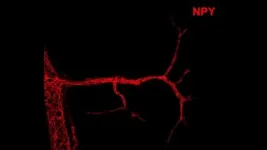(Press-News.org) An international team of researchers has discovered a new component of the peripheral nervous system that acts by increasing energy metabolism in the body. The finding paves the way for the development of simpler and cheaper drugs to control obesity and weight gain, regardless of the amount of food ingested.
In an article published in the journal Nature, researchers from the University of Oxford in the United Kingdom and the Obesity and Comorbidities Research Center (OCRC) – funded by FAPESP and based at the State University of Campinas (UNICAMP) in Brazil – describe where and how this component of the peripheral nervous system acts through neuropeptide Y (NPY) on energy and calorie expenditure.
This neurotransmitter, which is responsible for passing information between one neuron and another in the brain, has been studied extensively by scientists in relation to the central nervous system, but its action in peripheral nerves (outside the brain and spinal cord) and its ability to act in fat cells (adipocytes) to protect the body against obesity had never been studied.
“Since this new component does not act on the brain, but on the periphery [peripheral nervous system] of the organism, it opens up a new perspective for the development of drugs that can treat obesity more easily, more efficiently and even more cheaply. This is because, unlike the latest anti-obesity drugs that act on the brain, the new therapeutic approach would not need to be a large molecule [biological drug], and much less be able to cross the [blood-brain] barrier that protects the brain, greatly simplifying issues of access and development of a new drug,” says Licio Velloso, principal investigator of the OCRC and one of the authors of the article.
It should be explained that the peripheral nervous system is divided into two major groups: the somatic and the autonomic. While the somatic nervous system regulates voluntary movements and sensations in the skin (touch, cold, heat), the other is responsible for movements such as heartbeat and blood pressure, which function independently of the individual’s will.
The autonomic nervous system is also divided into two parts. The sympathetic branch is responsible for preparing the body for situations of alertness, coping, or fleeing from a threat. It therefore involves changes such as an accelerated heartbeat and increased energy expenditure. The parasympathetic nervous system, on the other hand, normalizes the functioning of the internal organs once the threat has passed.
“Neuroanatomy textbooks, for example, describe the sympathetic nervous system as working by releasing noradrenaline at the nerve terminals. In the study, however, it was found that in addition to noradrenaline, these nerves also express neuropeptide Y, something previously unknown in this part of the nervous system. When NPY is active in the hypothalamus, the individual feels hungry. In the peripheral nervous system, on the other hand, NPY was found to have the opposite effect, accelerating metabolism and, consequently, energy expenditure,” Velloso explains.
Accelerated metabolism
In addition to proving the existence of the new component, Oxford researchers showed that NPY acts on one-third of the sympathetic nerves distributed throughout the body, promoting the production of new fat cells involved in thermogenesis (burning energy and producing heat).
Unlike white adipose tissue, which stores excess calories consumed, brown and beige adipocytes play a metabolically beneficial role by using stored fat to release heat.
In the laboratory of researcher Ana Domingos in Oxford, scientists have discovered that the release of NPY in the peripheral nervous system takes place in synapses that are in contact with mural cells (located around the blood vessels that infiltrate the tissues). “An important feature of mural cells is that they’re precursors of a specific type of adipose tissue, brown adipose tissue, which is essential for regulating metabolism,” Velloso told Agência FAPESP. “In this way, the Oxford research team found that when the nerve connects to a mural cell via a synapse, it releases NPY and activates the differentiation of the mural cell, which becomes a precursor of brown adipose tissue, something very important for greater metabolic control.”
The last part of the study was carried out in the UNICAMP laboratory. To characterize the action of the new peripheral nervous system component, the researchers used mice genetically modified to not express neuropeptide Y in the sympathetic nervous system.
“We observed that these animals became more obese and had difficulty maintaining a stable body temperature when exposed to cold [low thermogenic capacity]. They also had metabolic disorders, such as a predisposition to developing diabetes. On the other hand, the animals with NPY that ate the same amount of food as the others showed protection against obesity,” she says.
Center versus periphery
One curiosity discovered by the group is that NPY has completely different effects on body weight when it is in the central nervous system and when it is in the peripheral nervous system. While in the brain NPY interferes with satiety – inducing hunger – in the periphery its relationship is with energy metabolism, promoting the proliferation of cells that burn fat instead of storing it.
“It was already known that thermogenic adipocytes can originate from mural cells. It was also known that mural cells can detect NPY because they have a receptor for this neuropeptide [the NPYR1 protein]. What we were able to show for the first time is that without NPY in the peripheral system, mice become obese – not because they eat more, but because they burn less fat. This mechanism probably generalizes to other types of obesity, as our study showed that these NPY-producing nerves degenerate with the onset of diet-induced obesity,” Domingos reports.
According to the researcher, the protective role of NPY against obesity now discovered in mice provides a biological mechanism that can be linked to a human genetic trait recently revealed by the Common Metabolic Diseases Knowledge Portal (CMDKP) – a data tool funded by the Accelerating Medicines Partnership (AMP) initiative of the Foundation for the National Institutes of Health (FNIH), a consortium that supports Domingos’ laboratory at the University of Oxford.
The tool, which quantifies the involvement of various genes in diseases, indicated that NPY is associated with human obesity, but not with altered eating patterns.
“This is quite surprising since there are dozens of studies showing the actions of NPY in brain neurons that promote food intake – hence its designation as an appetite stimulant [orexigenic peptide],” she says.
“How, then, could alterations in NPY be paradoxically associated with a high body mass index [BMI] in humans, but not with changes in eating patterns? Our study reveals a possible explanation for this by suggesting that energy dissipation may play a more crucial role than appetite in maintaining body weight in some individuals – although not in most of them,” Domingos concludes.
According to Velloso, the discovery and characterization of this new component of the autonomic nervous system – which regulates metabolism in the body’s periphery – paves the way for the development of new drug therapies for obesity.
“The expectation is that a molecule – probably a ligand for the neuropeptide Y receptor – could act by increasing metabolism, the burning of calories, which is exactly what we found that NPY does in the peripheral nervous system,” she says.
About FAPESP
The São Paulo Research Foundation (FAPESP) is a public institution with the mission of supporting scientific research in all fields of knowledge by awarding scholarships, fellowships and grants to investigators linked with higher education and research institutions in the state of São Paulo, Brazil. FAPESP is aware that the very best research can only be done by working with the best researchers internationally. Therefore, it has established partnerships with funding agencies, higher education, private companies, and research organizations in other countries known for the quality of their research and has been encouraging scientists funded by its grants to further develop their international collaboration.
END
Study reveals new factor involved in controlling calorie expenditure
Researchers from the University of Oxford and Unicamp have discovered a neuropeptide that acts on the peripheral nervous system, to speed up metabolism. The finding opens the way to more efficient and cheaper treatments for obesity
2024-11-25
ELSE PRESS RELEASES FROM THIS DATE:
Managing forests with smart technologies
2024-11-25
Deforestation has remained a significant issue globally, with primary forests contributing to 16 per cent of the total tree cover loss in the last two decades, driven by climate change and intensive human activity. This threatens natural resources, biodiversity, and people’s quality of life. To protect forests, Lithuanian scientists, in collaboration with Swedish experts, have developed Forest 4.0, an intelligent forest data processing model integrating blockchain, Internet of Things (IoT), and Artificial Intelligence (AI) technologies. The system ...
Clinical trial finds that adding the chemotherapy pill temozolomide to radiation therapy improves survival in adult patients with a slow-growing type of brain tumor
2024-11-25
Both radiation and temozolomide, a generic chemotherapy treatment in pill form, have meaningful single-modality anti-tumor activity against slow-growing, low-grade gliomas. The randomized phase 3 trial E3F05 by the ECOG-ACRIN Cancer Research Group (ECOG-ACRIN) tested whether combined therapy using temozolomide alongside radiation therapy is more effective than radiation therapy alone in these patients. The trial followed 172 patients for more than 10 years, and its results have an immediate clinical impact by providing the first evidence from a randomized phase 3 trial that temozolomide improves long-term survival for these patients.
“We found that the 10-year ...
H.E.S.S. collaboration detects the most energetic cosmic-ray electrons and positrons ever observed
2024-11-25
The Universe teems with extreme environments, ranging from the very coldest temperatures to the highest energy sources possible. As a consequence, extreme objects such as supernova remnants, pulsars and active galactic nuclei are capable of emitting charged particles and gamma rays with incredibly high energies, so high that they exceed the energy produced by the nuclear fusion in stars by several orders of magnitude.
The gamma rays detected on Earth tell us a great deal about these sources, since they travel through space undisturbed. However, in the case of charged particles, ...
Novel supernova observations grant astronomers a peek into the cosmic past
2024-11-25
COLUMBUS, Ohio – An international team of researchers has made new observations of an unusual supernova, finding the most metal-poor stellar explosion ever observed.
This rare supernova, called 2023ufx, originated from the core collapse of a red supergiant star, exploded on the outskirts of a nearby dwarf galaxy. Results of the study showed that observations of both this supernova and the galaxy it was discovered in are of low metallicity, meaning they lack an abundance of elements heavier than hydrogen or helium.
Since the metals produced within supernovae ...
Association of severe maternal morbidity with subsequent birth
2024-11-25
About The Study: The findings of this study suggest that women who experience severe maternal morbidity in their first birth are less likely to have a subsequent birth. Adequate reproductive counseling and enhancing antenatal care are crucial for women with a history of severe maternal morbidity.
Corresponding Author: To contact the corresponding author, Eleni Tsamantioti, MD, MMedSc, email eleni.tsamantioti@ki.se.
To access the embargoed study: Visit our For The Media website at this link https://media.jamanetwork.com/
(doi:10.1001/jama.2024.20957)
Editor’s ...
Herodotus' theory on Armenian origins debunked by first whole-genome study
2024-11-25
Armenians, a population in Western Asia historically inhabiting the Armenian highlands, were long believed to be descendants of Phrygian settlers from the Balkans. This theory originated largely from the accounts of the Greek historian Herodotus, who observed that Armenians were armed in Phrygian fashion when serving in the Persian army. Linguists further supported this theory, suggesting that the Armenian language shares ties with the Thraco-Phrygian subgroup of Indo-European languages.
But the first whole-genome study is challenging this long-held belief, revealing no significant genetic link between ...
Women who suffer pregnancy complications have fewer children
2024-11-25
Women who suffer severe complications during their first pregnancy or delivery are less inclined to have more babies, a study published in JAMA by researchers at Karolinska Institutet reports. Given the recent steady decline in birth rate in Sweden, the researchers propose monitoring in antenatal care to address the problem.
“The clinical monitoring of these women is essential, and they need individualised advice on possible future pregnancies,” says the study’s first author Eleni Tsamantioti, doctoral student at the Department of Medicine in Solna, Karolinska Institutet.
Birth rates and fertility have both been in steady decline ...
Home testing kits and coordinated outreach substantially improve colorectal cancer screening rates
2024-11-25
CHAPEL HILL, North Carolina—Colorectal cancer screening is an effective tool for catching the disease early when it's most treatable, yet it is underutilized in patient populations who receive primary care at federally qualified health centers (FQHC).
A new study by researchers at UNC Lineberger Comprehensive Cancer Center demonstrated that a targeted intervention can substantially increase screening rates in patients who are not current with recommended screening. The researchers report in JAMA Network Open that mailing at-home ...
COVID-19 vaccine reactogenicity among young children
2024-11-25
About The Study: No unexpected reactions were identified in this analysis of reactions to COVID-19 vaccines among children. Similar to this study, data from clinical trials and V-safe found that irritability was the most common systemic reaction among children ages 6 months to younger than 2 years, followed by fever and fatigue or sleepiness. In contrast to other studies observing a higher prevalence of reactions after the second COVID-19 vaccine dose, this study observed a higher prevalence after the first dose. This difference may reflect maternal vaccination; the ...
Generalizability of clinical trials of novel weight loss medications to the US adult population
2024-11-25
About The Study: This study estimates that approximately one-third of U.S. adults without diabetes who were eligible for weight loss treatment with glucagon-like peptide 1 (GLP-1) and glucose-dependent insulinotropic polypeptide (GLP-1/GIP) were excluded from clinical trials supporting these medications’ safety and effectiveness. Until there is evidence from high-quality postmarketing studies, the FDA should consider updating labeling to advise caution on generalizing the safety and effectiveness of GLP-1 and GLP-1/GIP to populations excluded from pivotal trials.
Corresponding Author: To contact the corresponding author, Timothy S. Anderson, MD, MAS, email tsander@pitt.edu.
To ...
LAST 30 PRESS RELEASES:
Why nail-biting, procrastination and other self-sabotaging behaviors are rooted in survival instincts
Regional variations in mechanical properties of porcine leptomeninges
Artificial empathy in therapy and healthcare: advancements in interpersonal interaction technologies
Why some brains switch gears more efficiently than others
UVA’s Jundong Li wins ICDM’S 2025 Tao Li Award for data mining, machine learning
UVA’s low-power, high-performance computer power player Mircea Stan earns National Academy of Inventors fellowship
Not playing by the rules: USU researcher explores filamentous algae dynamics in rivers
Do our body clocks influence our risk of dementia?
Anthropologists offer new evidence of bipedalism in long-debated fossil discovery
Safer receipt paper from wood
Dosage-sensitive genes suggest no whole-genome duplications in ancestral angiosperm
First ancient human herpesvirus genomes document their deep history with humans
Why Some Bacteria Survive Antibiotics and How to Stop Them - New study reveals that bacteria can survive antibiotic treatment through two fundamentally different “shutdown modes”
UCLA study links scar healing to dangerous placenta condition
CHANGE-seq-BE finds off-target changes in the genome from base editors
The Journal of Nuclear Medicine Ahead-of-Print Tip Sheet: January 2, 2026
Delayed or absent first dose of measles, mumps, and rubella vaccination
Trends in US preterm birth rates by household income and race and ethnicity
Study identifies potential biomarker linked to progression and brain inflammation in multiple sclerosis
Many mothers in Norway do not show up for postnatal check-ups
Researchers want to find out why quick clay is so unstable
Superradiant spins show teamwork at the quantum scale
Cleveland Clinic Research links tumor bacteria to immunotherapy resistance in head and neck cancer
First Editorial of 2026: Resisting AI slop
Joint ground- and space-based observations reveal Saturn-mass rogue planet
Inheritable genetic variant offers protection against blood cancer risk and progression
Pigs settled Pacific islands alongside early human voyagers
A Coral reef’s daily pulse reshapes microbes in surrounding waters
EAST Tokamak experiments exceed plasma density limit, offering new approach to fusion ignition
Groundbreaking discovery reveals Africa’s oldest cremation pyre and complex ritual practices
[Press-News.org] Study reveals new factor involved in controlling calorie expenditureResearchers from the University of Oxford and Unicamp have discovered a neuropeptide that acts on the peripheral nervous system, to speed up metabolism. The finding opens the way to more efficient and cheaper treatments for obesity





